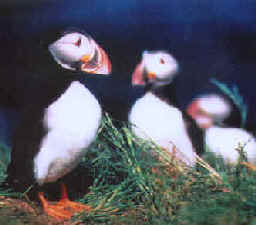 Birds & Mammals
Birds & Mammals
that can be found during
FONT Birding & Nature Tours in
Newfoundland, Canada
During the Summer in
July
List compiled by Armas Hill
Codes:
c: common
u: uncommon, or local
r: rare
vr: very rare
v: a vagrant
b: breeds
ir: irruptive, more common some years than others
yr: occurs year-round
(t):
a globally threatened or
rare species, designated by Birdlife International.
(t1): critical
(t2): endangered (t3): vulnerable
(nt): a near-threatened species
globally.
(NFi): introduced in Newfoundland
Links:
Upcoming
Newfoundland Tour Itineraries

Birds:
- Red-throated Loon ______
u,b (called
Red-throated Diver
in
the Old World)
Gavia stellata (monotypic)
- Common Loon ______ c,b
(called Great Northern Diver in the Old World)
Gavia immer (monotypic)
- Pied-billed Grebe ______
u
Podilymbus podiceps
- Horned Grebe ______ r
(called Slavonian Grebe in the Old World)
Podiceps
auritus
- Northern Fulmar ______ c
Fulmarus glacialis
- Cory's Shearwater ______ r
Calonectris diomedea
- Greater Shearwater______ c
Puffinus gravis
- Sooty Shearwater _____ c
Puffinus griseus
- Manx Shearwater ______
u
Puffinus puffinus
- Wilson's Storm-Petrel ______u
Oceanites oceanicus
- Leach's Storm-Petrel ______ c,b
Oceanodroma l. leucorhoa
- Northern Gannet ______ c,b
Morus (formerly Sula) bassanus
(monotypic)
- American White Pelican ______ vr
Pelecanus erythrorhynchos
- Double-crested Cormorant ______ u,b
Phalacrocorax a. auritus
- Great Cormorant ______ u,b
Phalacrocorax c, carbo
- American Bittern _____ u,b
Botaurus lentiginosus
- Least Bittern ______ r
Ixobrychus exilis
- Great Blue Heron ______ u
Ardea herodias
- Great Egret ______ r
Ardea alba
- Snowy Egret ______ r
Egretta thula
- Little Blue Heron ______ r
Egretta caerulea
- Tricolored Heron ______ vr
Egretta tricolor
- Cattle Egret ______ r
Bubulcus ibis (the single member of its genus)
- Green Heron______ vr (was at one time considered
conspecific with the nearly-cosmopolitan Striated Heron, and was then called
Green-backed Heron)
Butorides virescens
- Black-crowned Night-Heron______ vr
Nycticorax nycticorax
- Yellow-crowned Night-Heron______ vr
Nyctanassa violacea (the
single member of its genus)
 Birds & Mammals
Birds & Mammals Birds & Mammals
Birds & Mammals![]()